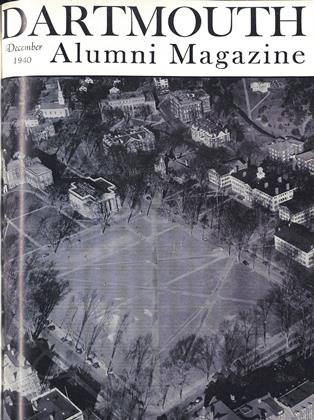OWEN M. SMITH, a New York insurance man, has solved the vexatious problem of imprinting the stamp of his personality—so that it sticks—upon a better-than-average share of his prospects. Considering that there are a lot of insurance men and a lot of Smiths in New York this is no mean achievement.
A graduate of both Dartmouth (Class of '23) and the Harvard School of Business, Mr. Smith entered the insurance field something more than a decade ago. A clear-sighted person, he knew he had chosen a flinty path. He had confidence in his ability to make a good impression during his first call on a fair proportion of prospects. But the trouble was, he reasoned, others would come along the next day, and the next week and the next month, making equally good impressions. He felt that the usual method of circularizing with insurance company literature would not be enough to lift him out of the rut.
Photography had been his hobby since childhood, and he had a stack of excellent prints. Why not use these on his mailing pieces in such a way that prospects would know him to be the camera-man ? He decided to distribute monthly calendar-blotters illustrated by his own pictures. He began this in September, 1929, and has not missed a month since then.
The blotters fit into a standard small-sized letter envelope. His name appears twice—under the photographs, as a credit line; and with his address and telephone number, under the calendar. His slogan also appears: "Plans Your Insurance to Insure Your Plans." The list averages about 300 names, and the monthly expense is about $20, for printing, stock, engraving and postage—but not including the cost of taking the photograph.
He watches the list closely, checking addresses and trimming off deadwood. He estimates that about 25% of those circularized fail to be impressed; they, or their secretaries, throw the blotters into the wastebasket. Those names come off in short order. This does not mean, however, that he ceases to consider them prospects for insurance—they are simply not to be reached with the blotters. Another 50% is interested and likes to receive them. The remaining 25% is enthusiastic, makes comments, and would squawk if the blotters failed to arrive on time.
"The blotters are not a crutch, and they alone can't sell for me," he told SM. "But they serve to keep my name before prospects. Besides, with the rising tide of interest in photography today, they provide a common meeting ground for me and many on the list. I have often been taken to lunch by clients who wanted my advice on what camera or enlarger to buy. Quite a few sizeable orders can be traced to the blotters. There was one annuity sale totaling well over $100,000. and there have been some nice life insurance orders."
He has experimented with his plan and learned what may be expected of it. He circularized a list of prospects, for example, to see whether the blotters alone would gain interviews for him. They did not. But they are an excellent form of follow-up. He uses them solely to gain good will, never enclosing them with bills or sales letters.
Recently Mr. Smith had an exhibition at Haber & Fink's, New York camera store, entitled, "Twenty Years in a Photographic Quandary—My Mistakes and How I Made Them." He had written the captions for the pictures himself, and they included both technical data and self-criticism. The prints were arranged chronologically, beginning with modest shots made with a No. 2 Brownie box camera and going on to recent pictures made with filters, flashguns and special lenses. He included clippings of some of his published work and a set of blotters. Sixty-six of those who saw the exhibit promptly requested to be put on his mailing list!
SALES MANAGEMENT,July, 1940.
Great stuff, Owen!
I hope aff this news of our really expert camera men won't deter you amateurs from sending in some of your pictures to use in this column. Perhaps I should address this plea to the wives because I'll bet they could dig up some snaps of the old man pulling out a trout or dropping in a putt that would be real additions to these notes. And we'd particularly like to get some of youse guys we haven't seen since 1933 or thereabouts.
And if you don't think that is a long time take a look at the list of freshmen sons of Dartmouth in the last issue of this MAGAZINE. The first time we have scored— Hartley Caldwell's son Hartley Jr., and Johnny Foster's stepson Chuck. Congratulations and lots of them to both the boys and their dads!
 View Full Issue
View Full Issue
More From This Issue
-
 Article
ArticleLike Father, Like Son
December 1940 By PETER STIRLING CARDOZO '39 -
 Article
ArticleAmerican Student Morale
December 1940 -
 Article
ArticleThe Undergraduate Chair
December 1940 By Charles Bolte '41 -
 Class Notes
Class Notes1917*
December 1940 By EUGENE D. TOWLER, DONALD BROOKS -
 Article
ArticleGreen Eleven Makes Gridiron History
December 1940 -
 Class Notes
Class Notes1935*
December 1940 By JOHN D. GILCHRIST JR., BOBB CHANEY







